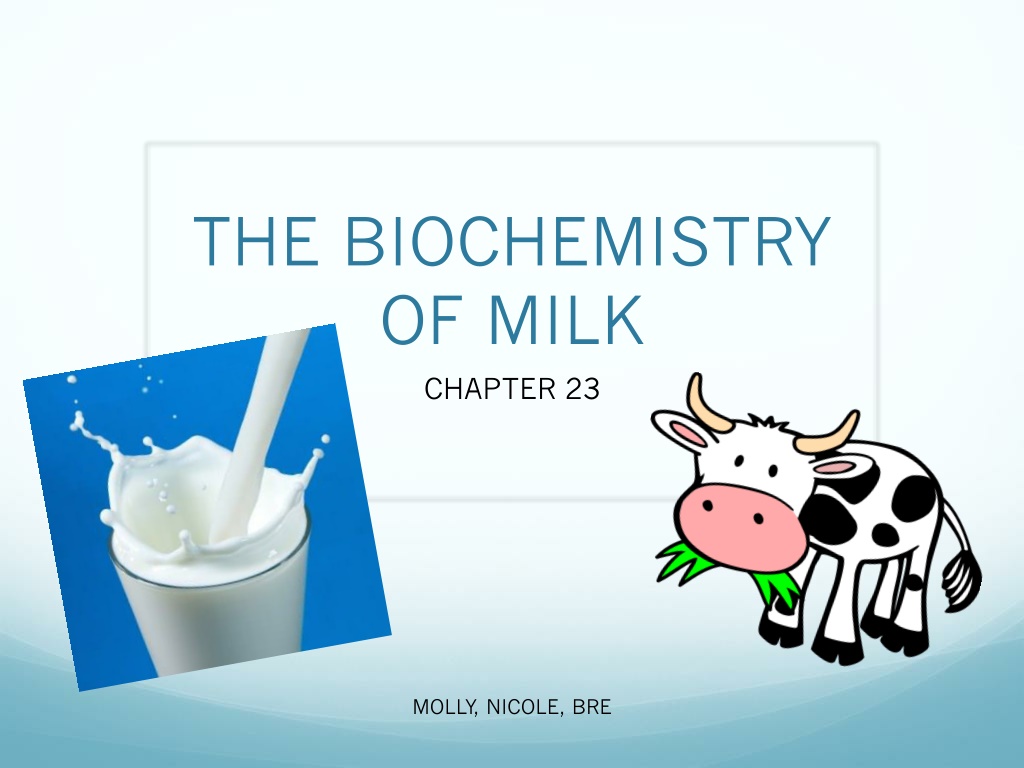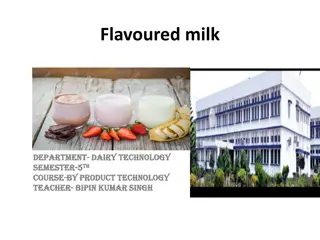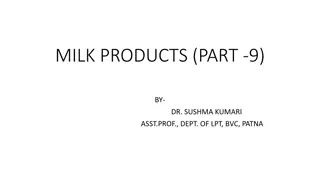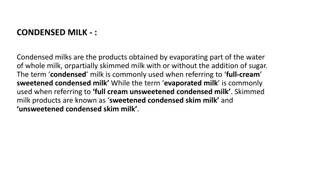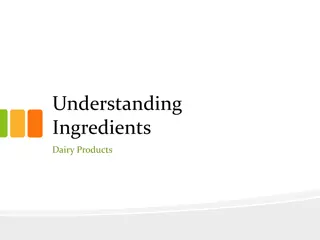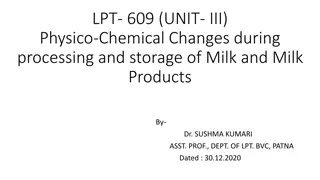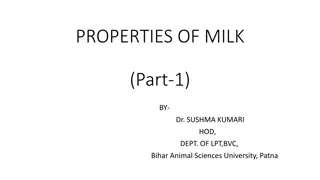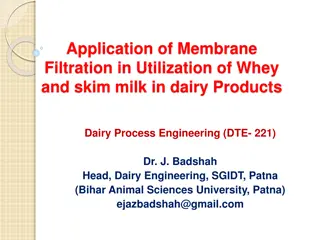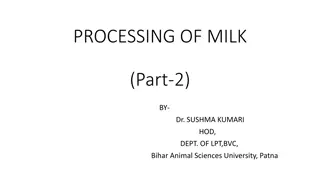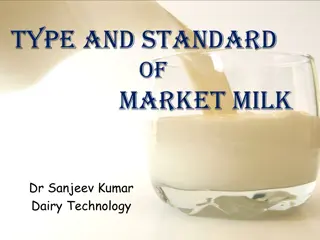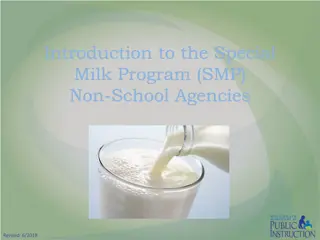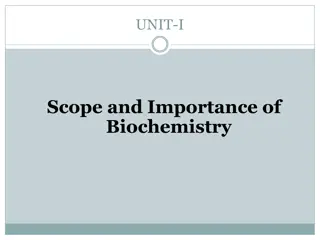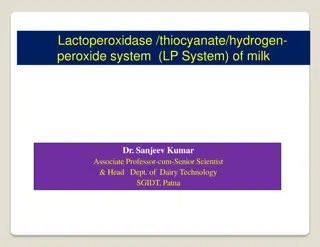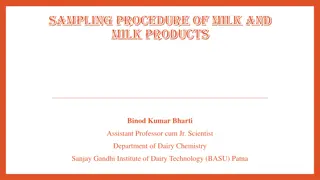Exploring the Biochemistry of Milk: Components, Processing, and Health Benefits
Delve into the intricate world of milk biochemistry with a focus on its components, processing methods, and health implications. Learn about the proteins, fats, carbohydrates, minerals, and vitamins present in milk, as well as how they contribute to its complex nature. Discover the various processes involved in milk production, including pasteurization, homogenization, and fortification. Uncover the significance of milk in maintaining health and its versatility in culinary applications.
Download Presentation

Please find below an Image/Link to download the presentation.
The content on the website is provided AS IS for your information and personal use only. It may not be sold, licensed, or shared on other websites without obtaining consent from the author. Download presentation by click this link. If you encounter any issues during the download, it is possible that the publisher has removed the file from their server.
E N D
Presentation Transcript
THE BIOCHEMISTRY OF MILK CHAPTER 23 MOLLY , NICOLE, BRE
OBJECTIVES Identify the components of milk and describe how they are dispersed in milk Explain what happens when milk protein is coagulated Describe how milk is processed and the effects of pasteurizing homogenizing and fortifying milk Distinguish the characteristics of various milk products Describe how cultured milk products are produced Explain how milk and milk products should be stored Relate certain factors to creams ability to foam Describe reactions that may occur when milk is heated VOCABULARY Carrageenin Casein Cream Creaming Culture Curds Fortification Incubation period Inoculation Lactose intolerant Micelles Milk solids Precipitate Shelf life Whey
Complex Nature of Milk Vital to Health Versatile for cooking A Solution A colloidal dispersion An emulsion
COMPOSITION OF MILK Contains all major nutrients Water 87% Protein - 3.5% Fat - 3.5% Carbohydrates - 5% Vitamins and Minerals
PROTEIN Milk contains Two Main Proteins Casein 80% of milk protein Micelles: cluster of molecules found in colloidal dispersions Make milk white Curds Casein clumps that separate from the liquid Whey 20% milk protein Protein found in liquid that remains after fat and casein have been removed from milk
FAT Emulsion Small globules of lipids are dispersed throughout water Creaming Fat droplets come together in clusters that rise and float to top of milk Cream Milk that is extra rich in emulsified fat droplets
CARBOHYDRATE Lactose or milk sugar is the main carbohydrate Lactose intolerance Inability to digest milk due to the absence of the lactase enzyme in intestines
MINERALS AND VITAMINS Natural salts Prevent milk from curdling Trace elements in milk; Cobalt Copper Iodine Iron Magnesium Nickel Molybdenum Vitamins in milk; Riboflavin Thiamin Niacim Vitamin A
Processing Milk Pasteurization heat treated to kill harmful bacteria Homogenization - process used to eliminate creaming Fortification adding nutrients to food, in milk vitamin D is added http://video.nationalgeographic.com/video/science/weird science sci/idkt milking cow/
Types of Milk Products Fluid Milk classified by fat content (skim, 1%, 2% and whole) Ultrahigh-Temperature Milk (UHT) special processing, can be stored without refrigeration up to 3 months Concentrated Milk (Evaporated Milk) 60% of water is evaporated Cream classified according to fat content (half & half, light whipping cream and heavy whipping cream) Dry Milk water is removed leaving dry solids
Cultured Milk Products Culture controlled bacterial population that is added to milk Inoculation starter is added to the milk to start the growth of bacteria Incubation period time bacteria has to grow and ferment the milk Buttermilk, Sour Cream, Yogurt and Cheese
Storing Milk and Milk Products Correctly storing milk and milk products helps maintain its quality and safety. Retains quality for 1 to 3 weeks when properly stored. Milk containers should be not transparent, sensitive to light. Nonfat dry milk should be stored at room temperature in packaging that keeps moisture out. An unrefrigerated product, processed cheese can be stored at room temperature until opened then should be refrigerated. Wrap cheese tightly to prevent it from drying out.
Cooking with Milk and Milk Products Making Foam gas bubbles trapped in a liquid Factors affect the ability of cream to form a foamy topping Fat Content higher the fat content, the better the foam Temperature Cold temperatures increase the viscosity of the cream Amount whipping small amounts gives better results Sugar content adding sugar decreases both volume and stiffness Heating Milk milk is sensitive and highly reactive to heat Heat denatures and coagulates the whey protein of fresh milk causing them to precipitate. Precipitate to cause a solid substance to separate from a solution
Cooking with Milk and Milk Products Enzyme Action When preparing desserts it is critical to maintain temperatures between 15 c. and 60 c. for enzyme action to occur. Acids High acid levels in fruit curdles milk, (example: in cereal) The protein casein precipitate out when the pH of milk drops to 4.6. Vegetables vary in how they cause milk to curdle.
